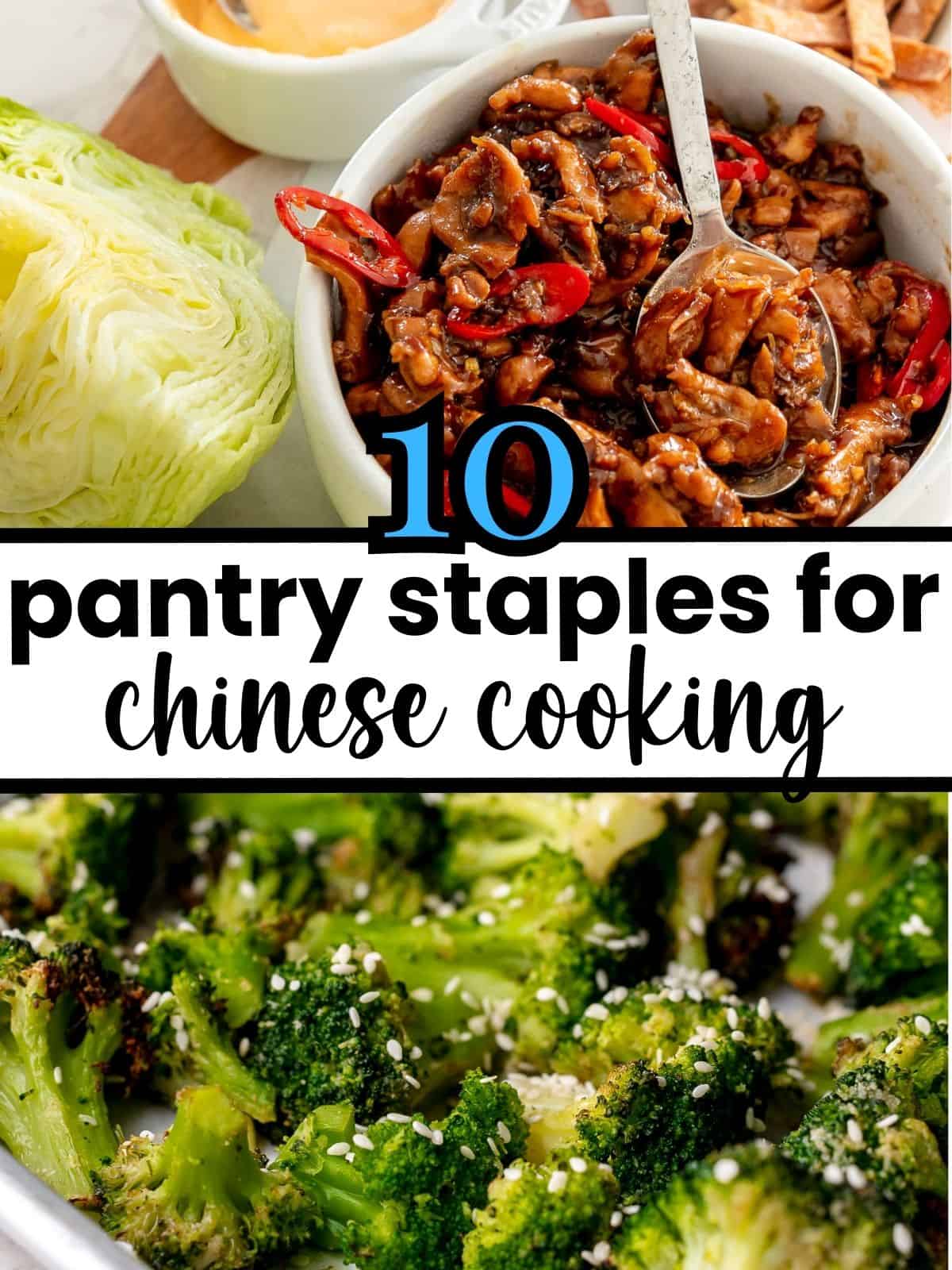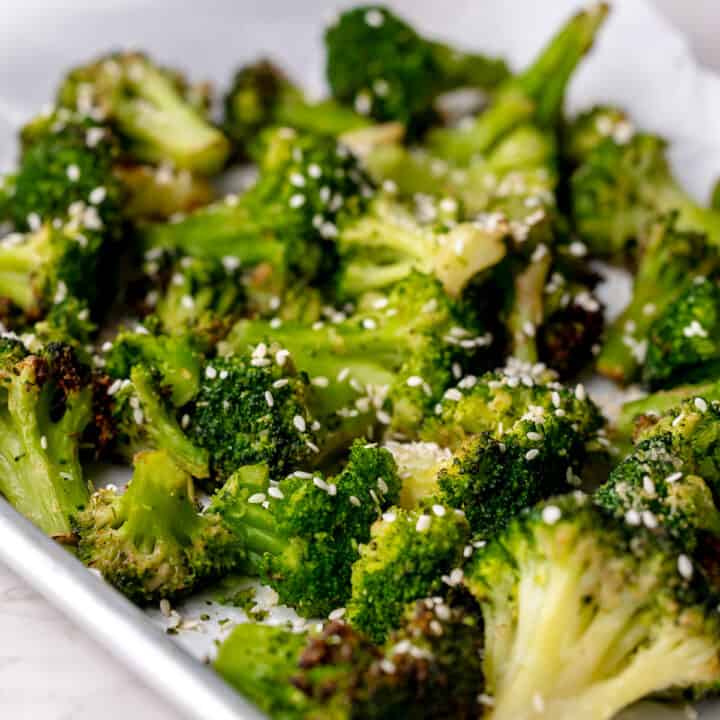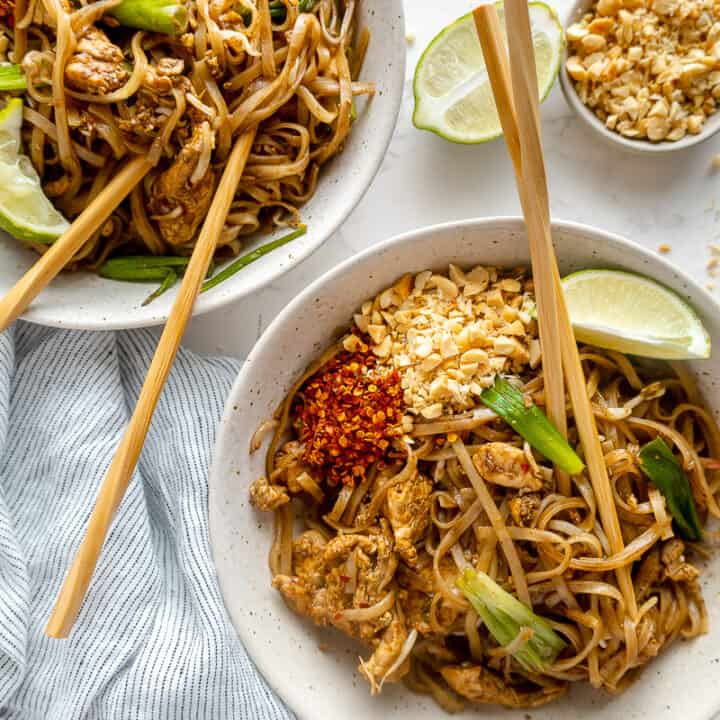If you enjoy cooking different cuisines on any given day of the week, a stocked pantry is a must. This list of 10 pantry staple ingredients for Chinese cooking will have you ready to enjoy your favorite stir-fries, noodle dishes, and soups, on demand!

Top 4 Favorite Chinese Recipes
- Szechuan chicken lettuce wraps: These JOEY restaurant copycat lettuce wraps are dressed with a sweet and spicy soy glaze that is perfectly balanced and packs a flavorful punch.
- Chinese garlic green beans: These Din Tai Fung crispy green beans come together in an umami-packed garlic and soy stir fry. Only 4 ingredients are needed, with no deep frying!
- Black pepper chicken: This black pepper chicken recipe is a copycat version of Panda Express' menu item. Tender, juicy chicken with the perfect balance of crisp veggies and a savory sauce with a kick makes a quick, easy, and delicious meal
- Dim sum cucumber salad: This dim sum cucumber salad is a copycat recipe from the popular Din Tai Fung restaurant. Fresh, crisp cucumbers get a flavourful twist with a salty, sour dressing with just the right amount of spice.
Cooking Sauces
Soy sauce
Soy sauce is one of the most commonly used sauces in Chinese cooking.
You can find soy sauce in regular or reduced-sodium varieties. If using multiple prepared sauces to make your recipe, reduced sodium is the better option for more control over salt levels.
You can also find light and dark soy sauce in most grocery stores. Light soy sauce is the most commonly used variety for saltiness and flavor. Dark soy sauce is a little bit thicker in viscosity and is used in smaller quantities for color.
Tamari, liquid aminos, and coconut aminos are great substitutes for soy sauce.
Oyster Sauce
Oyster sauce is a thick, savory sauce that is used in not only Chinese cooking, but other Asian cuisines like Thai, and Vietnamese recipes.
Like soy sauce, oyster sauce is relatively salty. It has more body and flavor from the actual oysters (or extract) that are used to make the sauce.
Oyster sauce does not taste fishy, but it does add some umami with a hint of sweetness to your recipes.
It's important to remember that oyster sauce is not vegetarian, and you will need to specifically buy vegetarian oyster sauce if this is important to you.
Hoisin Sauce
Hoisin sauce is sometimes referred to as "Chinese barbecue sauce." One of the key ingredients in hoisin sauce is fermented soybeans with some garlic, vinegar, and other delicious flavorings.
Hoisin is much thicker than soy sauce and has slight notes of five-spice powder.
Just like oyster sauce, hoisin also has a good amount of saltiness in it. When using hoisin sauce in combination with other staple sauces, you will always want to taste the recipe for salt to keep the flavors balanced.
Sesame Oil
Sesame oil is typically used in smaller quantities, as it packs a punch.
There are two varieties of sesame oil that you will commonly see: toasted, and untoasted.
The toasted variety is what you will most commonly find in the grocery store, with a darker color. It is important to note that you should not cook with toasted sesame oil like a regular cooking oil.
Untoasted sesame oil is lighter in color, similar to other neutral oils like vegetable or canola oil. Untoasted sesame oil can also be used just like other neutral oils for cooking and stir-fries.
Most sauce recipes refer to toasted sesame oil.
Shaoxing Cooking Wine
Shaoxing cooking wine is one of the most commonly used ingredients that separates restaurant dishes from home cooking.
This rice wine adds sweetness and complexity to most sauce recipes.
Keep in mind that this wine is strictly for cooking, and is used in smaller quantities. It adds a delicious background flavor that you can't detect easily but will make a difference if it is missing.

Dried Spices & Flavoring
Chinese Five-Spice Powder
Five-spice powder is indeed, a mix of five spices. Most common five-spice powders are a mix of:
- Star anise
- Cloves
- Cinnamon
- Sichuan pepper
- Fennel
If you have a well-stocked spice cabinet or drawer, you can mix together your own homemade five-spice powder if you prefer. You can easily find pre-mixed versions in most grocery stores, though.
Sichuan Peppercorns
Sichuan pepper is known for the mouth-numbing that many people experience when eating them.
These peppercorns are berries that are harvested and dried. Sichuan peppercorns add a multi-layered flavor and spice versus typical chilies.
You may need to go to a specialty Asian market to find good quality Sichuan peppercorns, as they are not as readily available in mainstream supermarkets.
Sesame seeds
You can find both black and white sesame seeds in most grocery stores.
The most commonly used are white sesame seeds, which are typically added as a garnish for a pop of texture.
Just like sesame oil, sesame seeds have a nutty, distinct flavor.
Chicken Bouillon Powder
This is one of the most underrated ingredients in Chinese cooking - especially in restaurant dishes.
Chicken bouillon powder is commonly used to add a layer of savory, umami flavor to stir-fries, sauces, and a lot of your favorite vegetable recipes, too. This is arguably one of the best-kept secrets of Chinese cooking.
Most Chinese recipes use powdered chicken bouillon specifically, but bouillon concentrate is also a great addition that offers the same saltiness and depth of flavor.
MSG
Last, but certainly not least, is MSG (monosodium glutamate).
MSG often has a bad reputation, and there are a number of conflicting claims surrounding the use of MSG in cooking.
Believe it or not, a small pinch of MSG is the secret to many restaurant-style Chinese recipes. It enhances the flavors of all the ingredients, which usually sets a restaurant recipe apart from one made at home.
MSG is not a must-use, but if you are looking to recreate specific restaurant recipes, you'll probably want to have it on hand.







Comments
No Comments